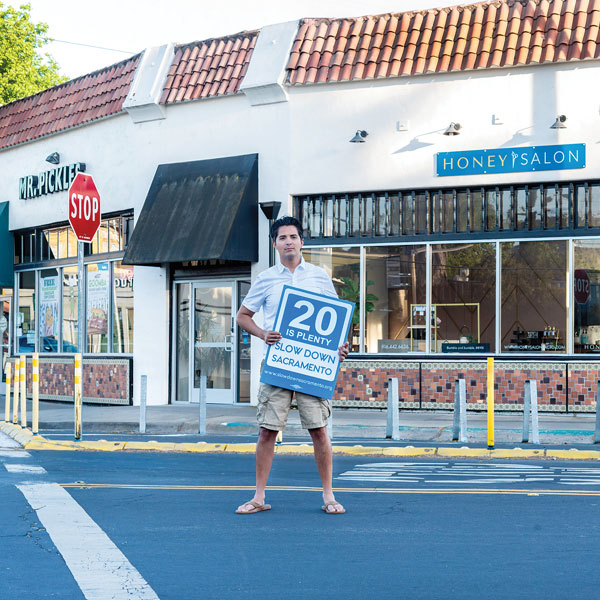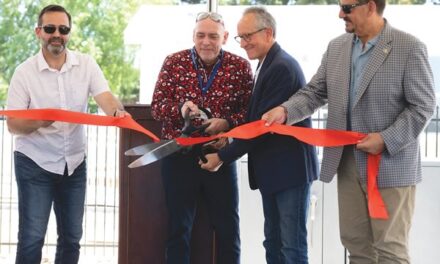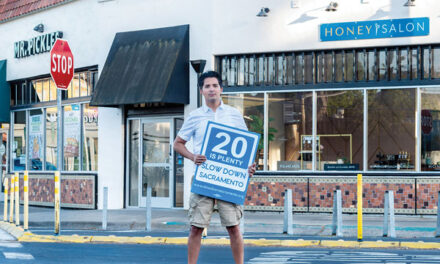Fatal Reaction
City finally moves to make streets safer
By Gary Delsohn
Photography By Aniko Kiezel
June 2025
Lewis Mumford, the great 20th century urbanist, social critic and author, was on target decades ago when he wrote, “Under the present dispensation, we have sold our urban birthright for a sorry mess of motorcars.”
Mumford was talking about sprawling suburban communities and their worship of wide streets and fast thoroughfares. Sacramento is finally getting Mumford’s message.
No one is predicting the automobile’s demise. But it’s encouraging to see city officials take pedestrian and cyclist safety more seriously with its Quick Build infrastructure program, designed to make streets work for everyone, including people not driving on them.

Much of the credit for the turnaround goes to the Sacramento Bee and reporter Ariane Lange, who drew attention to the high number of local traffic fatalities and how our streets became more dangerous with each passing year.
As Lange wrote last December in one of her many stories on the issue, “In the eight years since Sacramento’s City Council made a ‘Vision Zero’ pledge to end traffic fatalities by 2027, more than 300 people have died on city streets.”
The Bee published articles about each of Sacramento’s 32 traffic fatalities last year, highlighting the city’s minimalist response.
The stories were personal and heartbreaking. One headline read: “Two grandmothers died blocks apart on a dangerous Sacramento road. Will the city fix it?” Lange’s opening sentence: “Qui Chang Zhu crossed the street with her grandson, and that’s how she ended up dead.”
With staff cuts and declining circulation and resources, the Bee, where I worked for 16 years, is a shadow of its former self. But this is first-rate, community-minded journalism. With results.
“Fatal crashes,” Lange wrote, “are almost always preventable through changes to infrastructure and public policy. Unlike some of the problems that plague Sacramento, the crisis of dangerous roads is neither mysterious nor complex: Staff in the Department of Public Works already know how to fix it.”
Enlightened by Lange and the Bee, along with the activist group Slow Down Sacramento and its founder Isaac Gonzalez, the City Council decided to invest $4.6 million in a series of modest projects that can slow traffic and save lives. Council took action after acknowledging in a staff report that Sacramento “has one of the highest rates of traffic-related fatalities and serious injuries among California cities.”
“The biggest part of Quick Build is changing the built environment,” Gonzalez told me. “You can narrow a lane with things you can get off the shelf at a store today. We divert traffic for events like the city marathon or the Midtown Farmers Market all the time. This is a new tool for Sacramento’s toolbox and it’s going to be a game changer.”
Lange declined to be interviewed but told me in an email, “It’s been a privilege to write about some of the families who have lost their loved ones.”
Since City Council’s unanimous vote to fund the program in April, Sacramento has committed to quickly hire a six-person Transportation Safety Team with three engineers, a traffic investigator and administrative analyst. They will focus on fast improvements at intersections, pedestrian crossings and other dangerous locations.
A city staff report says the team will:
• Implement quick, cost-effective solutions that can be deployed within months, rather than years.
• Use real-time crash data to identify high-risk areas in collaboration with the Police Department’s Traffic/Major Collision Investigation Unit.
• Address community-reported safety concerns with targeted infrastructure changes.
To save time, the program will suspend competitive bids on different improvements and focus on modest fixes that can be done fast with immediate impact, such as:
“Installation and removal of roadway signs, including posts and strap-and-saddle installation; installation and removal of roadway lane striping; installation and maintenance of green bike lane pavement treatment; installation, removal, and maintenance of pavement markings, including crosswalks, word and arrow markings, railroad crossing markings, and bike lane legends; removal of pavement markings by approved grinding method; pavement repair necessary to cover pavement markings removals with approved surface treatment.”
As Megan Carter, traffic engineer and Public Works transportation division manager, told Bee reporter Lange, “The methodology of the past wasn’t working.”
Let’s hope these quick fixes have their intended result. Our streets belong to all of us. Not just the sorry mess of motorcars Mumford warned about.
Gary Delsohn can be reached at gdelsohn@gmail.com. Follow us on Facebook and Instagram: @insidesacramento.
















